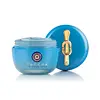What's inside
What's inside
 Key Ingredients
Key Ingredients

 Benefits
Benefits

 Concerns
Concerns

 Ingredients Side-by-side
Ingredients Side-by-side

Water
Skin ConditioningSqualane
EmollientDimethicone
EmollientPropanediol
SolventGlycerin
HumectantDiisostearyl Malate
EmollientOryza Sativa Bran Wax
Skin ConditioningBehenyl Alcohol
EmollientCamellia Sinensis Leaf
PerfumingIndigofera Tinctoria Leaf Extract
Skin ConditioningPolygonum Tinctorium Leaf/Stem Extract
Skin ConditioningAvena Sativa Kernel Extract
AbrasiveSophora Japonica Flower Extract
Skin ProtectingOryza Sativa Germ Oil
EmollientCocos Nucifera Oil
MaskingInositol
HumectantSericin
Skin ConditioningTetrasodium Tetracarboxymethyl Naringeninchalcone
Skin ConditioningAmorphophallus Konjac Root Powder
AbrasiveSodium Hyaluronate
HumectantSorbitan Tristearate
EmulsifyingTrihydroxystearin
Skin ConditioningDimethicone/Vinyl Dimethicone Crosspolymer
Skin ConditioningBeheneth-20
EmulsifyingBis-Diglyceryl Polyacyladipate-2
EmollientEthylhexylglycerin
Skin ConditioningButylene Glycol
HumectantSodium Dilauramidoglutamide Lysine
HumectantDisodium EDTA
Ethylhexyl Palmitate
EmollientSodium Acrylate/Acryloyldimethyltaurate/Dimethylacrylamide Crosspolymer
Emulsion StabilisingPhenoxyethanol
PreservativeCI 77891
Cosmetic ColorantMica
Cosmetic ColorantWater, Squalane, Dimethicone, Propanediol, Glycerin, Diisostearyl Malate, Oryza Sativa Bran Wax, Behenyl Alcohol, Camellia Sinensis Leaf, Indigofera Tinctoria Leaf Extract, Polygonum Tinctorium Leaf/Stem Extract, Avena Sativa Kernel Extract, Sophora Japonica Flower Extract, Oryza Sativa Germ Oil, Cocos Nucifera Oil, Inositol, Sericin, Tetrasodium Tetracarboxymethyl Naringeninchalcone, Amorphophallus Konjac Root Powder, Sodium Hyaluronate, Sorbitan Tristearate, Trihydroxystearin, Dimethicone/Vinyl Dimethicone Crosspolymer, Beheneth-20, Bis-Diglyceryl Polyacyladipate-2, Ethylhexylglycerin, Butylene Glycol, Sodium Dilauramidoglutamide Lysine, Disodium EDTA, Ethylhexyl Palmitate, Sodium Acrylate/Acryloyldimethyltaurate/Dimethylacrylamide Crosspolymer, Phenoxyethanol, CI 77891, Mica
Water
Skin ConditioningGlycerin
HumectantCocamidopropyl Betaine
CleansingCoco-Glucoside
CleansingSodium Lauroyl Methyl Isethionate
CleansingCocamidopropyl Hydroxysultaine
CleansingSodium Methyl Oleoyl Taurate
CleansingPropanediol
SolventAloe Barbadensis Leaf Extract
EmollientGlycolipids
Skin ConditioningLinoleic Acid
CleansingLinolenic Acid
CleansingLauryl Glucoside
CleansingCucumis Melo Cantalupensis Fruit Extract
AstringentSclerocarya Birrea Seed Oil
HumectantDipotassium Glycyrrhizate
HumectantTocopherol
AntioxidantCitric Acid
BufferingPhenoxyethanol
PreservativeSodium Hydroxide
BufferingSodium Benzoate
MaskingSodium Chloride
MaskingPolylysine
Water, Glycerin, Cocamidopropyl Betaine, Coco-Glucoside, Sodium Lauroyl Methyl Isethionate, Cocamidopropyl Hydroxysultaine, Sodium Methyl Oleoyl Taurate, Propanediol, Aloe Barbadensis Leaf Extract, Glycolipids, Linoleic Acid, Linolenic Acid, Lauryl Glucoside, Cucumis Melo Cantalupensis Fruit Extract, Sclerocarya Birrea Seed Oil, Dipotassium Glycyrrhizate, Tocopherol, Citric Acid, Phenoxyethanol, Sodium Hydroxide, Sodium Benzoate, Sodium Chloride, Polylysine
 Reviews
Reviews

Ingredients Explained
These ingredients are found in both products.
Ingredients higher up in an ingredient list are typically present in a larger amount.
Glycerin is already naturally found in your skin. It helps moisturize and protect your skin.
A study from 2016 found glycerin to be more effective as a humectant than AHAs and hyaluronic acid.
As a humectant, it helps the skin stay hydrated by pulling moisture to your skin. The low molecular weight of glycerin allows it to pull moisture into the deeper layers of your skin.
Hydrated skin improves your skin barrier; Your skin barrier helps protect against irritants and bacteria.
Glycerin has also been found to have antimicrobial and antiviral properties. Due to these properties, glycerin is often used in wound and burn treatments.
In cosmetics, glycerin is usually derived from plants such as soybean or palm. However, it can also be sourced from animals, such as tallow or animal fat.
This ingredient is organic, colorless, odorless, and non-toxic.
Glycerin is the name for this ingredient in American English. British English uses Glycerol/Glycerine.
Learn more about GlycerinPhenoxyethanol is a preservative that has germicide, antimicrobial, and aromatic properties. Studies show that phenoxyethanol can prevent microbial growth. By itself, it has a scent that is similar to that of a rose.
It's often used in formulations along with Caprylyl Glycol to preserve the shelf life of products.
Propanediol is an all-star ingredient. It softens, hydrates, and smooths the skin.
It’s often used to:
Propanediol is not likely to cause sensitivity and considered safe to use. It is derived from corn or petroleum with a clear color and no scent.
Learn more about PropanediolWater. It's the most common cosmetic ingredient of all. You'll usually see it at the top of ingredient lists, meaning that it makes up the largest part of the product.
So why is it so popular? Water most often acts as a solvent - this means that it helps dissolve other ingredients into the formulation.
You'll also recognize water as that liquid we all need to stay alive. If you see this, drink a glass of water. Stay hydrated!
Learn more about Water